A O T E A R O A
(Land of the Long White Cloud)prepared by Don R. Hender

Much more romantic and picturesque is the Polynesian name for the
Islands of New
Zealand. New Zealand has two large major Islands, the North Island
and the South
Island. Approximately 1000 miles from Cape Rangi of the North to
the Southern
reaches of the Southern Island. New Zealand supports a
tropical/sub-tropical
climate in the north to a full four season climate in the south.
I suppose to a meteorologist it is obvious how the Maori name for the island evolved. As the
weather systems come upon the raised lands of the 1,000 miles of the two major islands
certainly greatlong weather clouds do appear to enshroud and float never endingly over the island's lands.
But to those who just enjoy the land, it is romantic and the cause of why New Zealand is one of
the greenest places on earth. And where else could you live in a Hobbit Hole Home?

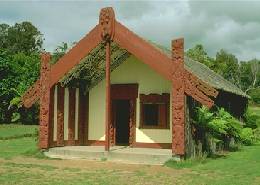
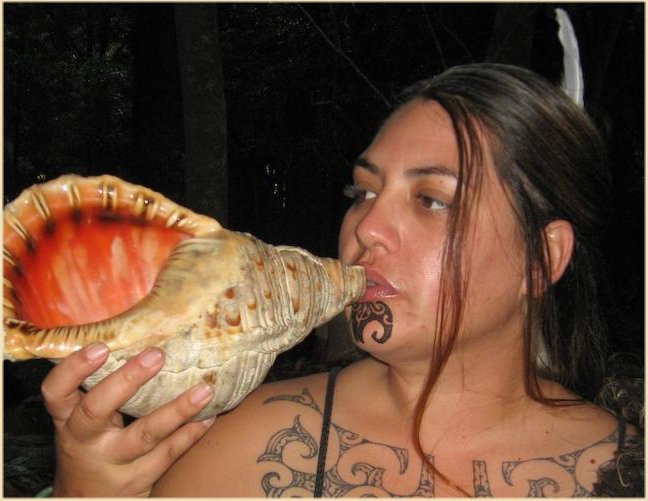 The Maori is the native people of New Zealand. For their origins
beyond other related polynesian groups, I'd would refer you to Thor
Heyerdahl and his text, American Indians in the Pacific; and to the fact that
'poly' means being of many. While science points solely to Asia, the facts
and logic bare sway that the sweet potato or kumara, the native blood types,
physical statures, and the similarity of cultures and languages point to the
Americas as the primary origin of these people. At the right is a Maori
meeting house or Pah. Note the 'totems' that decorate the Pah.
The Maori is the native people of New Zealand. For their origins
beyond other related polynesian groups, I'd would refer you to Thor
Heyerdahl and his text, American Indians in the Pacific; and to the fact that
'poly' means being of many. While science points solely to Asia, the facts
and logic bare sway that the sweet potato or kumara, the native blood types,
physical statures, and the similarity of cultures and languages point to the
Americas as the primary origin of these people. At the right is a Maori
meeting house or Pah. Note the 'totems' that decorate the Pah.
Like the natives of America, those of the South Seas also relented
to the white
man's persistence for their lands. New Zealand's British history
stems from
Captain Cook and Aotearoa being claimed by the British as a Common
Wealth
country.
 King Tawhiao* summarizes the maori. Tawhiao Potatau Wherowhero
[Tukaroto
Potatau Matutaera Tawhiao] was made the second Maori
King in 1860. He was of high lineage, being a direct descendant of
Hoturoa, the
chief who commanded his ancestral canoe Tainui on the migration
from Hawaiki. He
opposed the British take over, but in 1884 he visited England with
some of his
chiefs.
King Tawhiao* summarizes the maori. Tawhiao Potatau Wherowhero
[Tukaroto
Potatau Matutaera Tawhiao] was made the second Maori
King in 1860. He was of high lineage, being a direct descendant of
Hoturoa, the
chief who commanded his ancestral canoe Tainui on the migration
from Hawaiki. He
opposed the British take over, but in 1884 he visited England with
some of his
chiefs.
 Among other Maori leaders and prophets, King Tawhiao foretold the
coming of the Mormons to New Zealand**. He
prophesied that missionaries would come in pairs from Kiwa, that
they would raise
their hands to the square when praying, and that they would
instruct them in
Maori. He prophesied that the day would come when there would be
a great building
on Tuhikaramea near Hamilton which is where the LDS Temple and
Church College is
located today.
Among other Maori leaders and prophets, King Tawhiao foretold the
coming of the Mormons to New Zealand**. He
prophesied that missionaries would come in pairs from Kiwa, that
they would raise
their hands to the square when praying, and that they would
instruct them in
Maori. He prophesied that the day would come when there would be
a great building
on Tuhikaramea near Hamilton which is where the LDS Temple and
Church College is
located today.
I'm kind of glad that it 'came to pass' as the New Zealand Temple
is the place
that
I was married in on December 20, 1969. Actually, I was married
twice that day.
Once in the visitor's center from whence this photo image was
taken, and once in
the
Temple across the street. New Zealand at that time did not
recognize the LDS
Temple
marriage as a New Zealand legal marriage, thus I was first married
'legally' and
then
in the temple on the same day.
While the native Maori is not the population's majority race due to
Captian Cooks discovery of New Zealand and the British Common Weath
system; they certainly have left their mark on the land as many
cities,
locations, and sites carry their Maori names. One hill's name
is:
'Taumatawhakatangihangakoauotamateaturipukakapikimaungahoronukupokaiwhenuakitanataha'
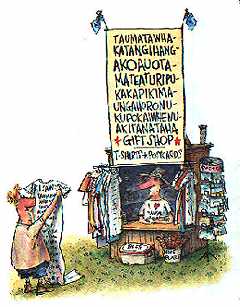 That's all 83 letters long of it. Say that one three times fast
without
swallowing your tongue. It just could be hazardous to your health.
And think of the
tourist t-shirt possibilities here. Talk about far away places
with strange
sounding names. But it's really not that bad, the 83-letter tongue
twister
is only a variant of the hill's name. The official name is a mere
57 letters long.
Some relief, huh? A Maori dictionary defines the name to mean 'the
brow of the hill where
Tamatea who sailed all around the land played his nose flute to his
That's all 83 letters long of it. Say that one three times fast
without
swallowing your tongue. It just could be hazardous to your health.
And think of the
tourist t-shirt possibilities here. Talk about far away places
with strange
sounding names. But it's really not that bad, the 83-letter tongue
twister
is only a variant of the hill's name. The official name is a mere
57 letters long.
Some relief, huh? A Maori dictionary defines the name to mean 'the
brow of the hill where
Tamatea who sailed all around the land played his nose flute to his
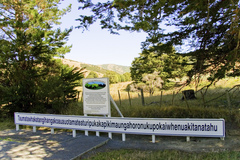 lady love.'
I hope that his flute melody was a little shorter than the hill's
name.
(National Geographic, August, 1995) And perhaps you think the cartoon an
exageration, note the actual location sign denoting the hill to the public.
The offical sign uses only the 57 letters long though there is the 83-letter
tongue twister variant as well. It is interesting that the Maori language combines
entire taught phrases into one word. Hebrew also uses short abreviations
combined to form one name such as 'Jehoshua', which means 'Jehovah the Deliverer'.
lady love.'
I hope that his flute melody was a little shorter than the hill's
name.
(National Geographic, August, 1995) And perhaps you think the cartoon an
exageration, note the actual location sign denoting the hill to the public.
The offical sign uses only the 57 letters long though there is the 83-letter
tongue twister variant as well. It is interesting that the Maori language combines
entire taught phrases into one word. Hebrew also uses short abreviations
combined to form one name such as 'Jehoshua', which means 'Jehovah the Deliverer'.
 Yes, the British ended the Maori's
monopoly on the Islands of New Zealand as they did throughout many of the Islands of
Polynesia. With the advent of the British to New Zealand, a new population majority
took over. And as you can see they have caused quite the traffic jam on their commute
to work each morning. I spent 2 years on New Zealand's North Island on a LDS Mission
and I know that New Zealand is not just rural farm and forest land. New Zealand has
many cities, of which Auckland on the North Island is the largest. Auckland's skyline
is no longer dominated by just its Harbor Bridge as it was when I was there. Yes, the British ended the Maori's
monopoly on the Islands of New Zealand as they did throughout many of the Islands of
Polynesia. With the advent of the British to New Zealand, a new population majority
took over. And as you can see they have caused quite the traffic jam on their commute
to work each morning. I spent 2 years on New Zealand's North Island on a LDS Mission
and I know that New Zealand is not just rural farm and forest land. New Zealand has
many cities, of which Auckland on the North Island is the largest. Auckland's skyline
is no longer dominated by just its Harbor Bridge as it was when I was there.

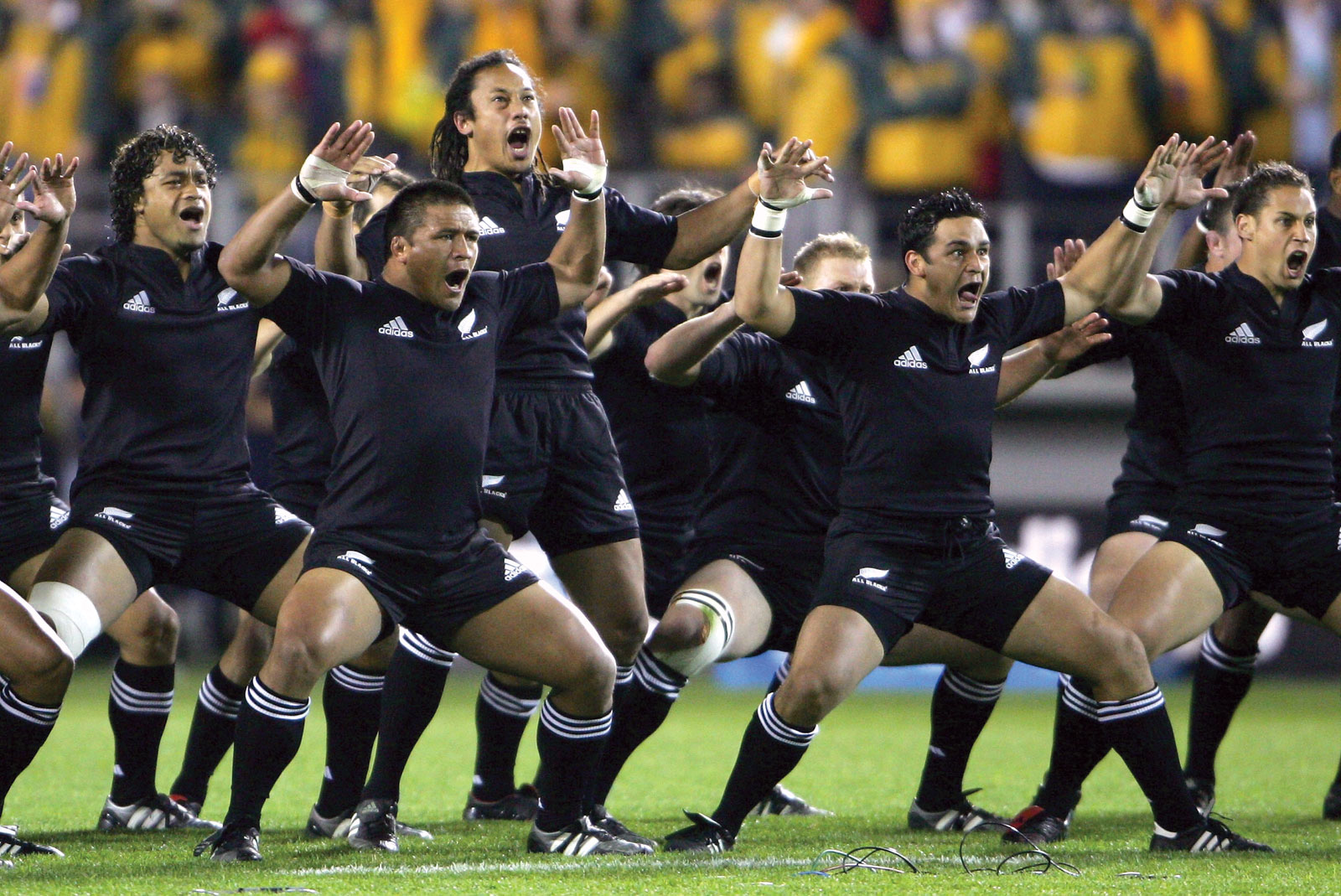 I don't know if there are a lot of changes since 1969, as the three 'sports' or 'past-times'
were then what we would jokingly refer to as 'Rugby', 'Racing' and 'Beer', but certainly
the All Blacks are still the talk of New Zealand and the world in Rugby and I imagine
that 'Ellerslie (horse) Racecourse' is still in full operation as well. I'd like to see
New Zealand again, visit One Tree Hill, the Domain, Ninty Mile Beach and the 'rip tides' flowing
seaward off Cape Rangi between the Pacific and Tasmanian or Tasman, Temple View and many many other
places. Once in a while
I still get to see a Maori Haka, usually being performed by the All Black's team, which
just happens to be heavily supplied by full-sized Maori bodies. And with all of this, I haven't
even said a word about going fishing in New Zealand.
I don't know if there are a lot of changes since 1969, as the three 'sports' or 'past-times'
were then what we would jokingly refer to as 'Rugby', 'Racing' and 'Beer', but certainly
the All Blacks are still the talk of New Zealand and the world in Rugby and I imagine
that 'Ellerslie (horse) Racecourse' is still in full operation as well. I'd like to see
New Zealand again, visit One Tree Hill, the Domain, Ninty Mile Beach and the 'rip tides' flowing
seaward off Cape Rangi between the Pacific and Tasmanian or Tasman, Temple View and many many other
places. Once in a while
I still get to see a Maori Haka, usually being performed by the All Black's team, which
just happens to be heavily supplied by full-sized Maori bodies. And with all of this, I haven't
even said a word about going fishing in New Zealand.
NEW ZEALAND CONNECTS ON THE INTERNET
 New Zealand/Aotearoa Guidebook New Zealand/Aotearoa Guidebook
PCC
Back to Hunter's South Pacific Page
Back home to Hunter's
* Tawhiao (Tukaroto Matutaera Potatau Te Wherowhero Tawhiao;[1] died 26 August 1894) was leader
of the Waikato tribes, the second Maori King and a religious visionary. He was a member of the
Ngati Mahuta iwi (tribe) of Waikato. [Wikipedia]
** "King Tawhaio prophesied that missionaries would come in pairs from Kiwa, that they would
raise their hands to the square (when praying); that they would instruct them in Moari. He
prophesied that that day would come when there would be a great building on Tuhikaramea near
Hamilton (i.e. Templeview where the Morman Temple and College have been located.") ~ ["The
Maori and Mormonism", by Ian Barker, Te Kaunihera Moari, Summer Issue 1969.]
“Our church is coming from the east—not a church paid with money. Its ministers go two by two;
when they pray they raise their hands. They will not come to go among the Pakeha (Europeans)
but will dine, live, talk, and sleep with you. The sign will be the writing of the names of
males, females and children. … Those churches that have already come are nothing, but when
these come that I speak about, do not disturb them—that will be your church!” King Tawhaio. ~
[Nolan P. Olsen, “New Zealand—Our Maori Home,” Improvement Era, 35 (May 1932):446.]
[Also see: Ensign magazine article here linked.]
|